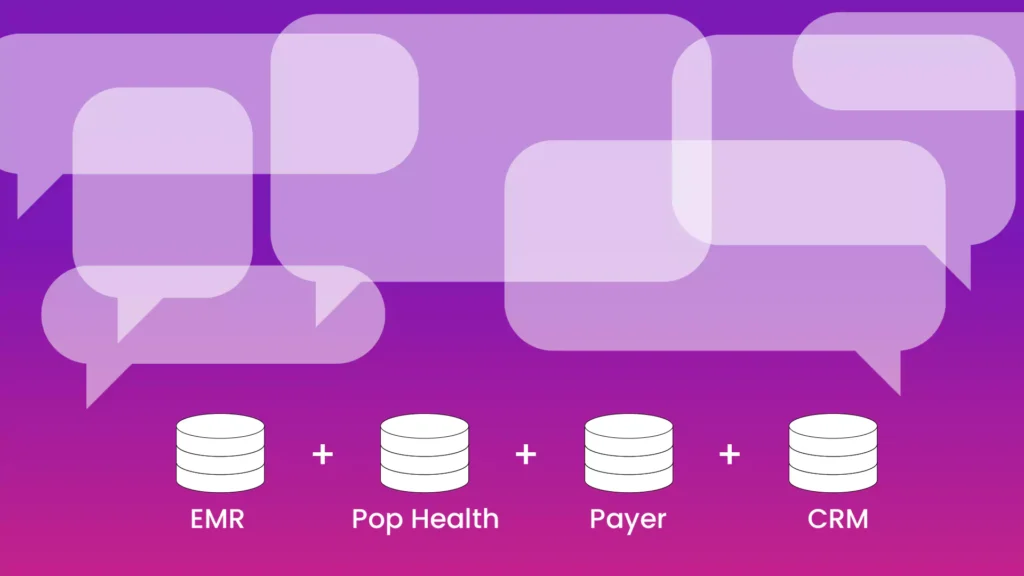Making sure your patients are engaged – one of two key elements driving patient experience – lays the foundation for stronger patient-provider relationships built on trust, empathy, and understanding. Positive relationships can help improve patient satisfaction and yield patient loyalty. And when a patient has a consistent, trusted source of healthcare, health outcomes can improve as well. Power to the patient is essential in this dynamic.
The Importance of Patient Engagement in Healthcare
Artera™ recently created “The Patient Engagement Playbook,” which offers six best practices for patient engagement to enable you to foster lasting connections with your patients that will ultimately lead to greater results for both your patients and your organization. The playbook will walk you through six critical steps to increase patient engagement – the fifth of which covers patient empowerment.
But before we dive into the significance of patient power and empowerment, let’s define engaged patients.
Engaged patients are:
- Informed – They understand their health status and the recommended treatment.
- Heard – They communicate with their providers and participate in shared decision-making.
- Empowered – They believe they can change their health outcomes.
- Active – They take action on their health based on personal learnings and overall understanding.
Although engaging patients – and keeping them engaged – can be challenging, it is a vital process for attracting and retaining them. Effectively engaging patients in their care is essential to improving health outcomes and staff efficiency, increasing patient satisfaction, and reducing costs while driving revenue.
“The Patient Engagement Playbook” discusses how greater patient engagement can:
Improve health outcomes: Strong patient engagement increases adherence to treatment regimen recommendations among patients, which in turn leads to fewer complications and re-hospitalizations. Several U.S. studies recently reported coordinated care trials that actively engaged patients with chronic disease resulted in significant mortality reductions compared to a control group who merely took appropriate medications. The studies suggest chronically ill patients who are engaged in their care live longer than unengaged peers who otherwise receive similar treatment, meaning health and well-being are fostered by engaged and activated patients. [1, 2, 3]
Enhance staff efficiency: Patient engagement strategies can help reduce front-end staff workload by reducing time spent on phone calls which take up a significant portion of time and can lead to support staff burnout. With more valuable time back, staff can spend more time on direct patient care.
Increase patient satisfaction: Personalized and unique patient engagement enables patients to feel heard and seen and empowers them to make decisions about their care. This can enhance overall satisfaction, and facilitate longer-standing relationships with providers while improving patient experience measures.
Reduce cost and drive revenue: Patient engagement directly contributes to outcomes affecting hospital costs and reimbursement for health systems. Executing effective patient engagement strategies also means better patient retention and referrals.
The Power of Patient Empowerment
Research tells us that self-advocacy in healthcare is important for patients and providers alike. But self-advocacy can be challenging in today’s world. This is why it’s rather crucial to “partner with patients,” says Meg Aranow, SVP, Platform Evangelist at Artera. Opportunities where patients are “invited in” to share responsibilities with providers, such as providing detailed symptom descriptions, can really advance patient empowerment and lead to improved health outcomes.
According to the World Health Organization, patient empowerment is “a process through which people gain greater control over decisions and actions affecting their health” and should be seen as both an individual and a community process. There are four core components that are considered fundamental to the process of patient empowerment:
- Understanding by the patient of his/her role
- Acquisition by patients of sufficient knowledge to be able to engage with their provider
- Patient skills
- The presence of a facilitating environment
To move this patient empowerment process forward, you must prioritize strategies that enable patients to get more involved and confident in their care journey, so they can become co-drivers of their own health. This is something that patients want too; in fact, American patients are demanding access to their health data so they can make informed decisions about where and how they receive care.
Transparency is key here. In a study done by OpenNotes, an international movement advocating greater healthcare transparency, patients with immediate access to their provider’s appointment notes were sixty percent more likely to adhere to medications, a major concern with managing chronic conditions. This is particularly striking considering 120,000 deaths in the U.S. each year are attributed to a lack of medication adherence. This ultimately suggests when patients are armed with accurate and timely information, they are likely to make better choices for their health.
Regardless of how patient empowerment unfolds, it has a similar result across the board: improved health outcomes. To get us thinking about specific patient empowerment strategies or methods, we’ve listed a few key ideas below.
1. Patient Education
Roughly 50 to 60 percent of patients remember key information from recent inpatient stays, including their diagnosis and even changes in their medication regimens, researchers from the University of Michigan School of Medicine recently wrote in The Joint Commission Journal on Quality and Patient Safety. This means that nearly half of patients are forgetting treatment plans.
This is why wider use of patient education tools like patient-provider communication or patient portal access is critical. By providing patients with resources through these tools, it will help them better understand their condition, care plan, treatment, or prescription. Make sure the patient’s individual needs are addressed in any materials you give to them and remember that patients have different learning styles, so ask each patient how they like to consume information and adjust accordingly. Here are a few other tips:
- Begin educating patients with every encounter from admission.
- Determine what the patient already knows and correct any misinformation.
- Provide comprehensive and detailed materials in layman’s terms. Utilize visual aids as often as possible.
- Question their understanding of the care, and plan for the next lesson.
- Ask the patient to tell you how they would explain (step-by-step) their disease or treatment to a loved one. If their family is present, have them summarize what they learned as well.
- Ensure the patient understands the medications as you administer them. Make sure they understand how and when to refill medications.
- Provide patients with information about signs and symptoms of their condition that will require immediate attention.
Did you know? Research suggests patients who clearly comprehend their after-hospital care instructions have over 30 percent less chance of readmission compared to others.
There are many ways to deliver patient education, including one-on-one teaching, demonstrations, or illustrations. The use of the patient voice – or direct patient feedback – can also be extremely valuable when educating patients. Hearing patient insights, as opposed to that of a medical professional, may make the information more relatable – sometimes even emotional and everlasting.
Whatever material you choose to distribute, be sure to take advantage of existing technology – this not only makes materials more accessible but can help to provide customized resources for specific individuals. Furthermore, you can emphasize the importance of regular preventive screenings or incorporate screenings into their regular practice workflows.
With evolving medical information about vaccines and other significant or timely healthcare matters, consumers are turning to their providers to get clear and accurate information. Enhancing your patient education process helps patients see you as a valuable source of health information, thus helping them remain engaged with their health and your practice specificially. Physicians and providers continue to offer a beacon of hope and support for many patients, with 94% of people saying their level of trust in their provider is the same or even more than it was before the pandemic.
Above all, educating your patients empowers them to stay connected in their health, leading to improved outcomes. For example, Kaiser Permanente previously developed the Collaborative Cardiac Care Service pilot program that used technology and data to develop patient engagement through proactive patient outreach and education, as well as lifestyle adjustments, and effective medication management, among other tactics.
The program achieved the following impressive results, according to a Healthcare IT News article:
- Patients have an 88 percent reduced risk of dying of a cardiac-related cause when enrolled within 90 days of a heart attack, compared to those not in the program;
- The number of patients meeting their cholesterol goal went from 26 percent to 73 percent; and
- The number of patients screened for cholesterol went from 55 percent to 97 percent.
2. Practice Shared Decision-Making
After you effectively educate your patients about their current health condition, medications, or treatment options and their potential side effects, you are able to engage in shared decision-making with them. According to the Patient Empowerment Network, shared decision-making is the “conversation that happens between patients and physicians to reach a healthcare choice together.” Praised across the industry for its clinical benefits and positive impact on patient engagement, shared decision-making is lauded as a driver of positive patient experience.
Since every patient is different and has their own specific goals regarding their health, it’s critical to discuss their unique wishes, intentions, or desired actions. Patients want this too: according to CVS Health’s Health Care Insights Study 2022, 80% of patients say it’s important their primary care providers be aware of their health goals. Peter Goldbach, MD, Chief Medical Officer at Health Dialog, summed it up nicely in an interview with PatientEngagementHIT.com: “The patient is the expert on the patient, so the provider needs that information. The provider is the expert on the disease, so the patient needs that information.”
Ultimately, when you better understand your patients’ health goals, you can help guide them toward making a choice in alignment with those goals. This is why the practice of shared decision-making, or collaborating with patients in selecting a certain care path, is critical in advancing patient empowerment and is a key component in patient-centered care. Patients who participate in this can feel like valued decision-makers of their own health, and according to a study published in the NCBI, these patients often report:
- higher levels of satisfaction
- have increased knowledge about conditions, tests, and treatment
- have more realistic expectations about benefits and harms
- are more likely to adhere to screening, diagnostic, or treatment plans
- have reduced decisional conflict and anxiety
- are less likely to receive tests or procedures which may be unnecessary
- in some cases, have improved health outcomes
According to the ONC, “Shared decision-making is a key component of patient-centered health care.” And with the shift toward patient-centered care today, it’s critical to be more intentional with your patients, asking them how they would like to receive care and in what ways they would like to be involved. This all ties back to stronger patient empowerment.
“Shared decision-making is not only conducive to reducing information asymmetry but also is ethically the right thing to do,” researcher Ming Tai-Seale, PhD, MPH, and his colleagues previously wrote in Health Affairs. “Systematic reviews of the preconditions for improving health care delivery have emphasized the importance of shared decision making as a mediator and moderator of health care quality.”
Implementing an effective and valuable shared decision-making strategy will ultimately hinge on strong patient outreach. Healthcare staff should rely heavily on their patient-provider communication skills to drive better patient education, decision-making, and patient empowerment.
When you enforce these practices, you can develop a deep understanding of your patient’s unique needs, which can strengthen the overall patient-provider relationship and enhance trust between the two. A collaborative partnership between patients and providers can lead to better medical decisions, educated and activated patients, and sustained patient interest in their ongoing care. This is why patient empowerment is so important.
Optimized patient engagement strategies are essential for healthcare providers looking to properly address patient needs, which have shifted dramatically as a result of healthcare consumerization and the COVID-19 pandemic. Now more than ever, providers need to consider the six strategies in The Patient Engagement Playbook to facilitate greater patient engagement, connection, and understanding.
Conversational Messaging in Healthcare: Power to the Patient
The healthcare industry is undergoing a significant transformation, with conversational messaging at the forefront of this change. Conversational messaging in healthcare is not just about sending and receiving messages; it’s about creating a personalized, interactive communication channel between patients and providers. This shift is truly giving back the power to the patient.
One of the most significant advantages of conversational messaging is the enhanced understanding it provides to patients. Traditional methods of communication in healthcare, such as one-way automations or generic emails and texts, often leave patients feeling disconnected and uninformed.
In contrast, conversational messaging drives a two-way, interactive dialogue, allowing patients to actively participate in their care. They can ask questions, seek clarifications, and receive instant feedback, ensuring they are well-informed at every step of their healthcare journey.
This interactive approach to communication empowers patients in several ways:
Improved Understanding of Healthcare Information
With conversational messaging, complex medical terms, test results, and treatment options are explained in a manner that’s easy for patients to understand. This clarity ensures that patients are not just passive recipients of care but active participants in their health decisions.
Efficient Scheduling and Care Coordination
Conversational messaging platforms often come with integrated scheduling tools, allowing patients to easily find and book appointments. This not only saves time but also ensures that patients receive timely care.
Swift Access to Test Results and Referrals
Waiting for test results can be anxiety-inducing for many patients. With conversational messaging, patients can receive their results faster and in a comprehensible format. Additionally, if a referral to a specialist is needed, the process becomes smoother and more efficient.
Empowered Decision Making
When patients have all the information they need at their fingertips, they can make better decisions about their care. Whether it’s choosing between treatment options or understanding the implications of a particular test result, conversational messaging ensures that patients have all the knowledge they need to make informed choices.
A recent Heartbeat Panel Recap by Artera highlighted the revolution brought about by conversational messaging in healthcare. It emphasized that this form of communication goes beyond traditional one-way communication, offering a more personalized and interactive patient-provider communication experience.
Conversational messaging is not just a technological advancement; it’s a paradigm shift in how healthcare is delivered and experienced. Placing the patient at the center of communication, truly gives back the power to the patient, enabling them to take a front-row, interactive, and powerful seat in their healthcare journey. This not only leads to better understanding and satisfaction but also paves the way for improved health outcomes.



